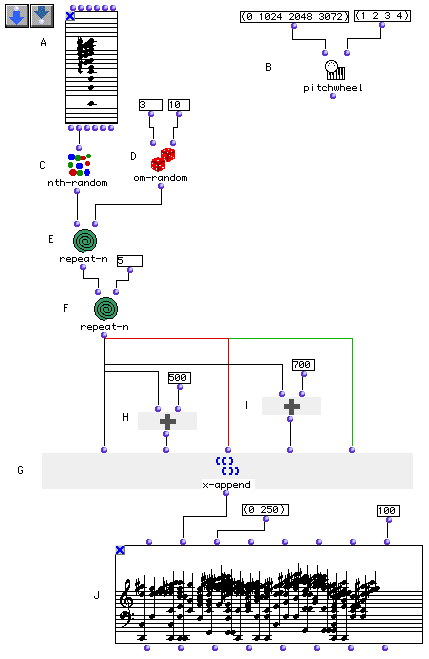OpenMusic Tutorials
Prev| Chapter 3. Using Aleatoric Elements| Next
Tutorial 11: Constructing a Chord with random notes from a
harmonic spectrum
Topics
Using a random functions to choose elements from a harmonic series which are then built into Chords
Key Modules Used
pitchwheel, x-append, om-
random, nth-random,
repeat-n, om+, Chord-seq
The Concept:
The repeat-n box evaluates the function at its first input
a number of times (indicated at the second input) and returns the result as a
list. The om-random box returns a random number between
its two inputs. We start with the harmonic spectrum chord generated in
Tutorial 8. We’ll build 5 groups of random chords from its elements, then
transpose the second of the groups up by a fourth and the fourth of the groups
up by a fifth, creating a sort of demented I-IV-I-V-I progression.
If you built a different harmonic series in Tutorial 8 and want to use it here, hold option and drag it into the Tutorial 11 window- this will create a copy of your original object. Note that this works with any object or group of objects.
The Patch:

nth-random (C) chooses a random note from the chord (A).
This is repeated by repeat-n (E) a random number of times
set by om-random (D). This will yield a list of random
midics of a random length. This entire operation is itself carried out 5 times
by the second repeat-n box (F). Each time it is evaluated
it returns a group of 5 chords (in midics) with between 3 and 10 members.
x-append creates a list with all its inputs. In this case,
all the inputs come from repeat-n. Since
repeat-n produces itself produces a list,
x-append will create a list of lists- what is called a
tree.
The second and fourth inputs to x-append are passed through
om+ (H & I) for a transposition. The others are untouched.
Note that x-append has 5 inputs here- each of those inputs
causes repeat-n to be evaluated anew. This means that each
group of 5 chords will be different, randomly generated.
The result of x-append is a list of lists. Remember the
discussion of data type in Tutorial 9? Well, the _lmidic_ input of the
Chord-seq object can take either a list of integers, in
which case it assumes they are individual notes to be taken in order, or a
list of lists, a tree, in which case it assumes each sublist represents a
chord. That is what happens here.
When you are done, you can play the Chord-seq. You may
need to evaluate the pitchwheel function in the upper-
right in order that the microtones play back correctly. (See Tutorial 10 for
more info).
Prev| Home| Next
—|—|—
Using Aleatoric Elements| Up| Tutorial 12: Building a
sequence of random notes: om-random